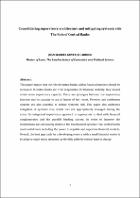| dc.creator | Gustale Cardoni, Juan Manuel |
| dc.date.accessioned | 2021-01-04T20:20:07Z |
| dc.date.available | 2021-01-04T20:20:07Z |
| dc.date.created | 2012-01-01 |
| dc.date.issued | 2012-01-01 |
| dc.identifier.citation | Alexander K, Banking Crisis: Regulation and Supervision in Iain MacNeil and Justin O’Brien (eds), The Future of Financial Regulation (Hart Publishing 2010). |
| dc.identifier.citation | Black J, Restructuring Global and EU Financial Regulation: Capacities, Coordination and Learning. (LSE Law, Society and Economy Working Papers 2010). |
| dc.identifier.citation | Brummer C, Soft Law and the Global Financial System. Rule Making in the 21st Century (Cambridge University Press 2012). |
| dc.identifier.citation | Campbell A. and Lastra R, Revisiting the Lender of Last Resort- The Role of the Bank of England in Iain MacNeil and Justin O’Brien (eds), The Future of Financial Regulation (Hart Publishing 2010). |
| dc.identifier.citation | Cranston R, Principles of Banking Law, (2nd edition, Oxford OUP 2002). |
| dc.identifier.citation | Danielsson J, (GLOBAL FINANCIAL SYSTEMS FM 447 SLIDES, London School of Economics 2011). |
| dc.identifier.citation | Davies H. and Green D, Banking on the Future: The Fall and Rise of Central Banking (Princeton University Press 2010). |
| dc.identifier.citation | de Larosière J, The High-Level Group on Financial Supervision in the EU Report. Chaired by Jacques de Larosière (Brussels 2009). |
| dc.identifier.citation | Goodhart and others, Financial Regulation. Why, How and where now? (Routledg, 1999). |
| dc.identifier.citation | Hadjiemmanuil C, Bank Resolution Policy and the Organization of Bank Insolvency Proceedings: Critical Dilemmas. David G. Mayes & Aarno Liuksila (eds), Who Pays for Bank Insolvency? (Palgrave 2004). |
| dc.identifier.citation | Llewellyin D, Institutional Structure of Financial Regulation and Supervision: the basic issues (Paper presented at a World Bank seminar Aligning Supervisory Structures with Country Needs 2006). |
| dc.identifier.citation | Lastra R, Northern Rock, UK bank insolvency and cross-border bank Insolvency, Journal of Banking Regulation. Vol. 9, 3 165–186 Palgrave Macmillan Ltd. 2008). |
| dc.identifier.citation | MacNeil I. and O’Brien J, The Future of Financial Regulation. (Hart Publishing 2010). |
| dc.identifier.citation | McCormick R, Legal Risk in the Financial Markets (2nd ed. Oxford University Press 2010). |
| dc.identifier.citation | Nier E, Financial Stability Frameworks and the Role of Central Banks: Lessons from the Crisis (International Monetary Fund Working Paper 2009). |
| dc.identifier.citation | Oxford Analytica, Strong growth boosts buoyant banks in Paraguay (Monday, February 20 2012). |
| dc.identifier.citation | Patrikis E, Higher Minimum Capital Standards: Basel Committee On Banking Supervision Crowns Common Equity King (Bureau of National Affair’s Banking Report 2010). |
| dc.identifier.citation | Persaud A, Macro-prudential regulation in Iain MacNeil and Justin O’Brien (eds), The Future of Financial Regulation. (Hart Publishing 2010). |
| dc.identifier.citation | Sea of Change. Regulatory reforms to 2012 and beyond May 2011. Bank resolution regimes comparative analysis (Clifford Chance May 2011) http://www.scribd.com/doc/62421543/Final-Bank-Resolution-Regimes-6011032 |
| dc.identifier.citation | The Turner Review, A regulatory response to the global banking crisis (The Financial Services Authority 2009). |
| dc.identifier.citation | The Federal Reserve System: Purposes and Functions <http://www.federalreserve.gov/> |
| dc.identifier.citation | Theissen R, (LL484 Regulation of Financial Markets Slides, London School of Economics 2012). |
| dc.identifier.citation | United Kingdom HM Treasury, A new approach to financial regulation: A blueprint for reform (2011). |
| dc.identifier.citation | Walker G, The Global Credit Crisis and Regulatory Reform. in Iain MacNeil and Justin O’Brien (eds), The Future of Financial Regulation. (Hart Publishing 2010). |
| dc.identifier.citation | 2011 International Monetary Fund IMF Country Report No. 11/198 Paraguay: Financial System Stability Assessment — Update (July 2011). |
| dc.identifier.uri | http://repositorio.bcp.gov.py/handle/123456789/150 |
| dc.description.abstract | This paper argues that the role of central banks within financial markets should be increased. If central banks are to be responsible for financial stability, they should retain some supervisory capacity. There are synergies between the supervisory function and its capacity to act as lender of last resort. Payment and settlement systems are also essential to reduce systemic risk. This paper also addresses mitigation of systemic risk, which was not appropriately managed during the crisis. An integrated supervisory approach is appropriate to deal with financial conglomerates and the parallel banking system. In order to improve the mechanisms and adequately diminish the likelihood of systemic risk, central banks need useful tools, including the power to regulate and supervise financial markets. Overall, the best approach for a developing country with a small financial sector is to adopt a single entity structure, preferably with the central bank in charge. |
| dc.format.extent | 61 páginas |
| dc.format.mimetype | application/pdf |
| dc.language.iso | eng |
| dc.publisher | BCP |
| dc.relation.ispartof | Artículos y Análisis de Discusión |
| dc.rights.uri | http://creativecommons.org/publicdomain/zero/1.0/ |
| dc.subject | BANCA CENTRAL |
| dc.title | Consolidating supervisory architecture and mitigating systemic risk.The role of Central Banks |
| dc.title.alternative | Consolidar la arquitectura supervisora y mitigar el riesgo sistémico. El papel de los bancos centrales |
| dc.type | article |
| dc.subject.keyword | CENTRAL BANK |
| dc.rights.accessRights | Open Access |
| dc.type.spa | Artículo |
| dc.type.hasversion | Published Version |
| dc.rights.cc | CC0 1.0 Universal |
| dc.rights.spa | Acceso abierto |
 This work is licensed under a Creative Commons Reconocimiento-NoComercial 4.0.This document has been deposited by the author (s) under the following certificate of deposit
This work is licensed under a Creative Commons Reconocimiento-NoComercial 4.0.This document has been deposited by the author (s) under the following certificate of deposit

